Business Law Report: Legal Solutions for Business Organizations
VerifiedAdded on 2021/02/20
|12
|3311
|97
Report
AI Summary
This report comprehensively examines various aspects of business law. It begins by outlining different sources of law, including legislation, common law, Acts of Parliament, and European law, and assesses the effectiveness of the legal system in terms of recent reforms. The report then delves into the role of government in law-making, explaining the process from the first reading to Royal Assent, and how statutory and common law are applied in justice courts. It analyzes the potential impact of company, employment, and contract law on businesses, as well as the impact of legislation, regulations, and standards. Furthermore, the report explores the legal formation, management, and funding of different types of business organizations, including sole proprietorships, partnerships, and limited companies, along with the advantages and disadvantages of each. Finally, it discusses legal solutions to various business challenges, comparing and contrasting their effectiveness.

Business law
Paraphrase This Document
Need a fresh take? Get an instant paraphrase of this document with our AI Paraphraser
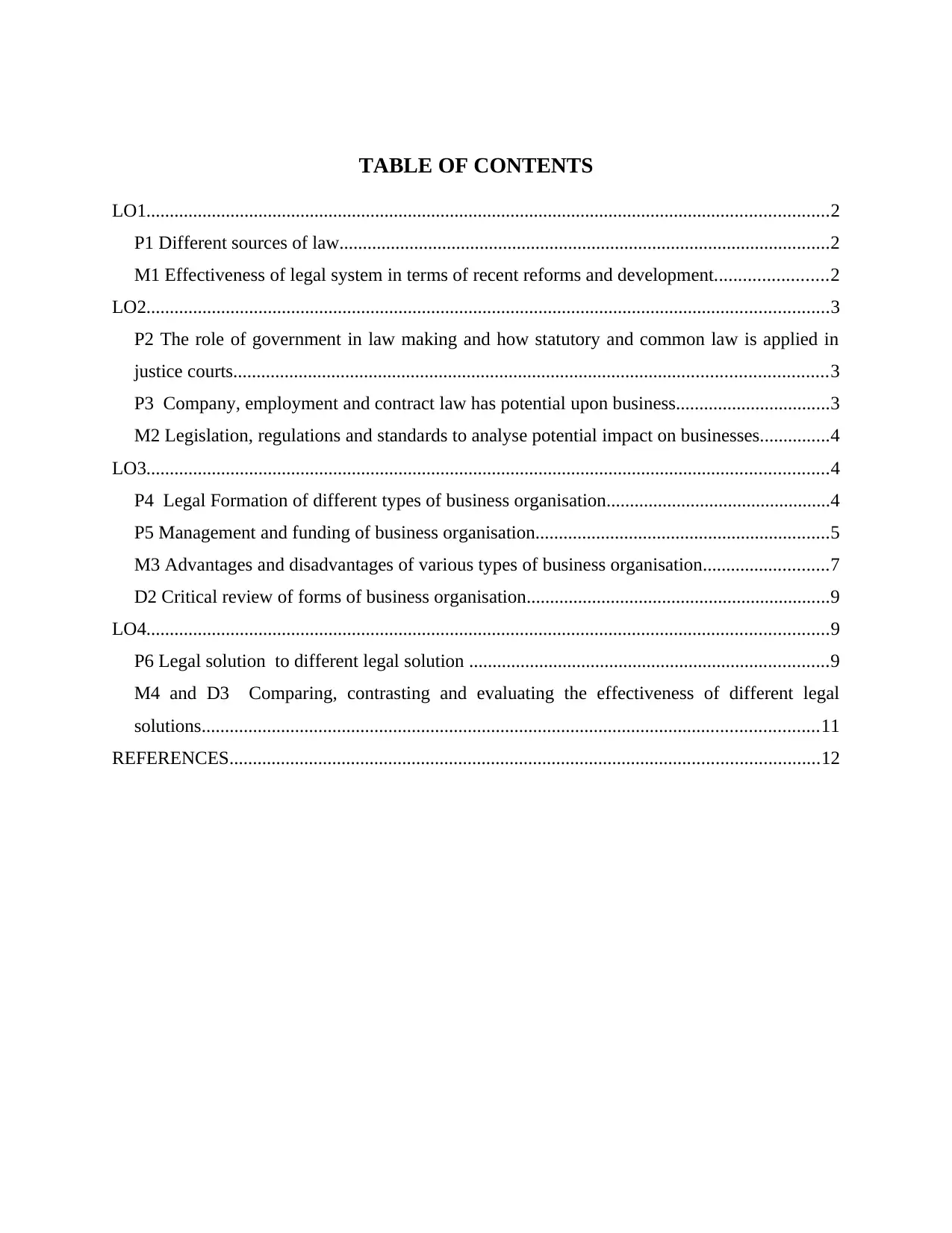
TABLE OF CONTENTS
LO1..................................................................................................................................................2
P1 Different sources of law.........................................................................................................2
M1 Effectiveness of legal system in terms of recent reforms and development........................2
LO2..................................................................................................................................................3
P2 The role of government in law making and how statutory and common law is applied in
justice courts...............................................................................................................................3
P3 Company, employment and contract law has potential upon business.................................3
M2 Legislation, regulations and standards to analyse potential impact on businesses...............4
LO3..................................................................................................................................................4
P4 Legal Formation of different types of business organisation................................................4
P5 Management and funding of business organisation...............................................................5
M3 Advantages and disadvantages of various types of business organisation...........................7
D2 Critical review of forms of business organisation.................................................................9
LO4..................................................................................................................................................9
P6 Legal solution to different legal solution .............................................................................9
M4 and D3 Comparing, contrasting and evaluating the effectiveness of different legal
solutions....................................................................................................................................11
REFERENCES..............................................................................................................................12
LO1..................................................................................................................................................2
P1 Different sources of law.........................................................................................................2
M1 Effectiveness of legal system in terms of recent reforms and development........................2
LO2..................................................................................................................................................3
P2 The role of government in law making and how statutory and common law is applied in
justice courts...............................................................................................................................3
P3 Company, employment and contract law has potential upon business.................................3
M2 Legislation, regulations and standards to analyse potential impact on businesses...............4
LO3..................................................................................................................................................4
P4 Legal Formation of different types of business organisation................................................4
P5 Management and funding of business organisation...............................................................5
M3 Advantages and disadvantages of various types of business organisation...........................7
D2 Critical review of forms of business organisation.................................................................9
LO4..................................................................................................................................................9
P6 Legal solution to different legal solution .............................................................................9
M4 and D3 Comparing, contrasting and evaluating the effectiveness of different legal
solutions....................................................................................................................................11
REFERENCES..............................................................................................................................12
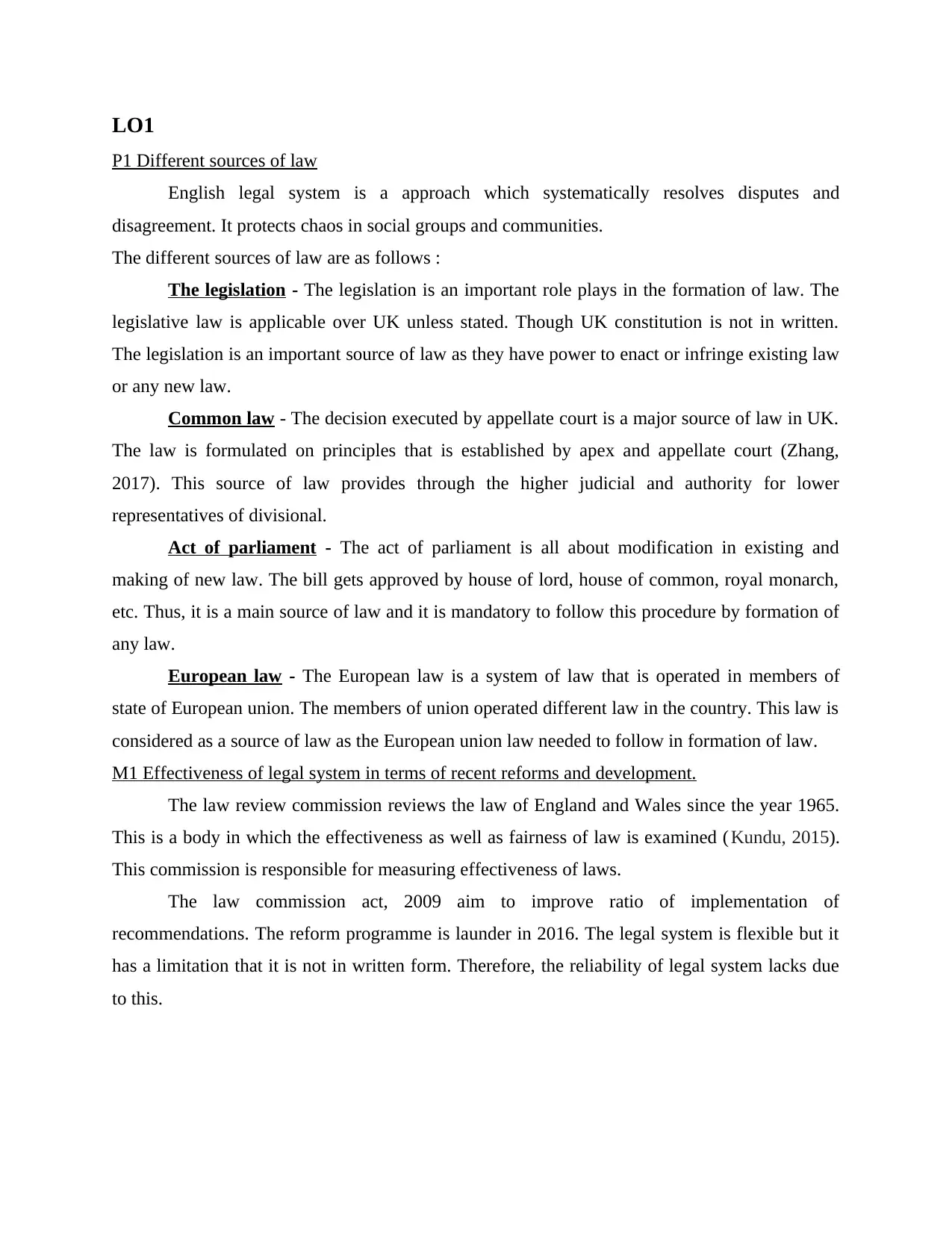
LO1
P1 Different sources of law
English legal system is a approach which systematically resolves disputes and
disagreement. It protects chaos in social groups and communities.
The different sources of law are as follows :
The legislation - The legislation is an important role plays in the formation of law. The
legislative law is applicable over UK unless stated. Though UK constitution is not in written.
The legislation is an important source of law as they have power to enact or infringe existing law
or any new law.
Common law - The decision executed by appellate court is a major source of law in UK.
The law is formulated on principles that is established by apex and appellate court (Zhang,
2017). This source of law provides through the higher judicial and authority for lower
representatives of divisional.
Act of parliament - The act of parliament is all about modification in existing and
making of new law. The bill gets approved by house of lord, house of common, royal monarch,
etc. Thus, it is a main source of law and it is mandatory to follow this procedure by formation of
any law.
European law - The European law is a system of law that is operated in members of
state of European union. The members of union operated different law in the country. This law is
considered as a source of law as the European union law needed to follow in formation of law.
M1 Effectiveness of legal system in terms of recent reforms and development.
The law review commission reviews the law of England and Wales since the year 1965.
This is a body in which the effectiveness as well as fairness of law is examined (Kundu, 2015).
This commission is responsible for measuring effectiveness of laws.
The law commission act, 2009 aim to improve ratio of implementation of
recommendations. The reform programme is launder in 2016. The legal system is flexible but it
has a limitation that it is not in written form. Therefore, the reliability of legal system lacks due
to this.
P1 Different sources of law
English legal system is a approach which systematically resolves disputes and
disagreement. It protects chaos in social groups and communities.
The different sources of law are as follows :
The legislation - The legislation is an important role plays in the formation of law. The
legislative law is applicable over UK unless stated. Though UK constitution is not in written.
The legislation is an important source of law as they have power to enact or infringe existing law
or any new law.
Common law - The decision executed by appellate court is a major source of law in UK.
The law is formulated on principles that is established by apex and appellate court (Zhang,
2017). This source of law provides through the higher judicial and authority for lower
representatives of divisional.
Act of parliament - The act of parliament is all about modification in existing and
making of new law. The bill gets approved by house of lord, house of common, royal monarch,
etc. Thus, it is a main source of law and it is mandatory to follow this procedure by formation of
any law.
European law - The European law is a system of law that is operated in members of
state of European union. The members of union operated different law in the country. This law is
considered as a source of law as the European union law needed to follow in formation of law.
M1 Effectiveness of legal system in terms of recent reforms and development.
The law review commission reviews the law of England and Wales since the year 1965.
This is a body in which the effectiveness as well as fairness of law is examined (Kundu, 2015).
This commission is responsible for measuring effectiveness of laws.
The law commission act, 2009 aim to improve ratio of implementation of
recommendations. The reform programme is launder in 2016. The legal system is flexible but it
has a limitation that it is not in written form. Therefore, the reliability of legal system lacks due
to this.
⊘ This is a preview!⊘
Do you want full access?
Subscribe today to unlock all pages.

Trusted by 1+ million students worldwide
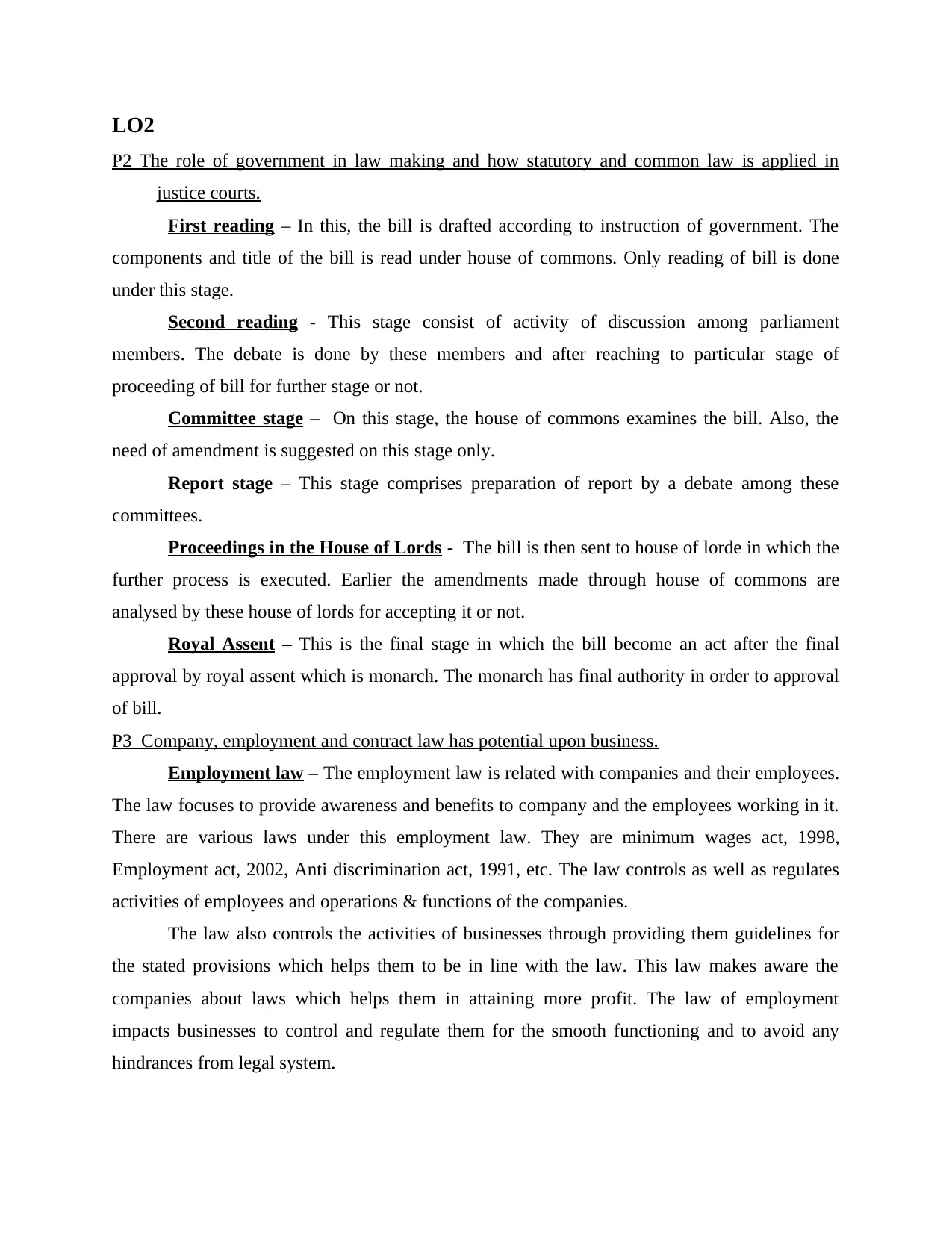
LO2
P2 The role of government in law making and how statutory and common law is applied in
justice courts.
First reading – In this, the bill is drafted according to instruction of government. The
components and title of the bill is read under house of commons. Only reading of bill is done
under this stage.
Second reading - This stage consist of activity of discussion among parliament
members. The debate is done by these members and after reaching to particular stage of
proceeding of bill for further stage or not.
Committee stage – On this stage, the house of commons examines the bill. Also, the
need of amendment is suggested on this stage only.
Report stage – This stage comprises preparation of report by a debate among these
committees.
Proceedings in the House of Lords - The bill is then sent to house of lorde in which the
further process is executed. Earlier the amendments made through house of commons are
analysed by these house of lords for accepting it or not.
Royal Assent – This is the final stage in which the bill become an act after the final
approval by royal assent which is monarch. The monarch has final authority in order to approval
of bill.
P3 Company, employment and contract law has potential upon business.
Employment law – The employment law is related with companies and their employees.
The law focuses to provide awareness and benefits to company and the employees working in it.
There are various laws under this employment law. They are minimum wages act, 1998,
Employment act, 2002, Anti discrimination act, 1991, etc. The law controls as well as regulates
activities of employees and operations & functions of the companies.
The law also controls the activities of businesses through providing them guidelines for
the stated provisions which helps them to be in line with the law. This law makes aware the
companies about laws which helps them in attaining more profit. The law of employment
impacts businesses to control and regulate them for the smooth functioning and to avoid any
hindrances from legal system.
P2 The role of government in law making and how statutory and common law is applied in
justice courts.
First reading – In this, the bill is drafted according to instruction of government. The
components and title of the bill is read under house of commons. Only reading of bill is done
under this stage.
Second reading - This stage consist of activity of discussion among parliament
members. The debate is done by these members and after reaching to particular stage of
proceeding of bill for further stage or not.
Committee stage – On this stage, the house of commons examines the bill. Also, the
need of amendment is suggested on this stage only.
Report stage – This stage comprises preparation of report by a debate among these
committees.
Proceedings in the House of Lords - The bill is then sent to house of lorde in which the
further process is executed. Earlier the amendments made through house of commons are
analysed by these house of lords for accepting it or not.
Royal Assent – This is the final stage in which the bill become an act after the final
approval by royal assent which is monarch. The monarch has final authority in order to approval
of bill.
P3 Company, employment and contract law has potential upon business.
Employment law – The employment law is related with companies and their employees.
The law focuses to provide awareness and benefits to company and the employees working in it.
There are various laws under this employment law. They are minimum wages act, 1998,
Employment act, 2002, Anti discrimination act, 1991, etc. The law controls as well as regulates
activities of employees and operations & functions of the companies.
The law also controls the activities of businesses through providing them guidelines for
the stated provisions which helps them to be in line with the law. This law makes aware the
companies about laws which helps them in attaining more profit. The law of employment
impacts businesses to control and regulate them for the smooth functioning and to avoid any
hindrances from legal system.
Paraphrase This Document
Need a fresh take? Get an instant paraphrase of this document with our AI Paraphraser
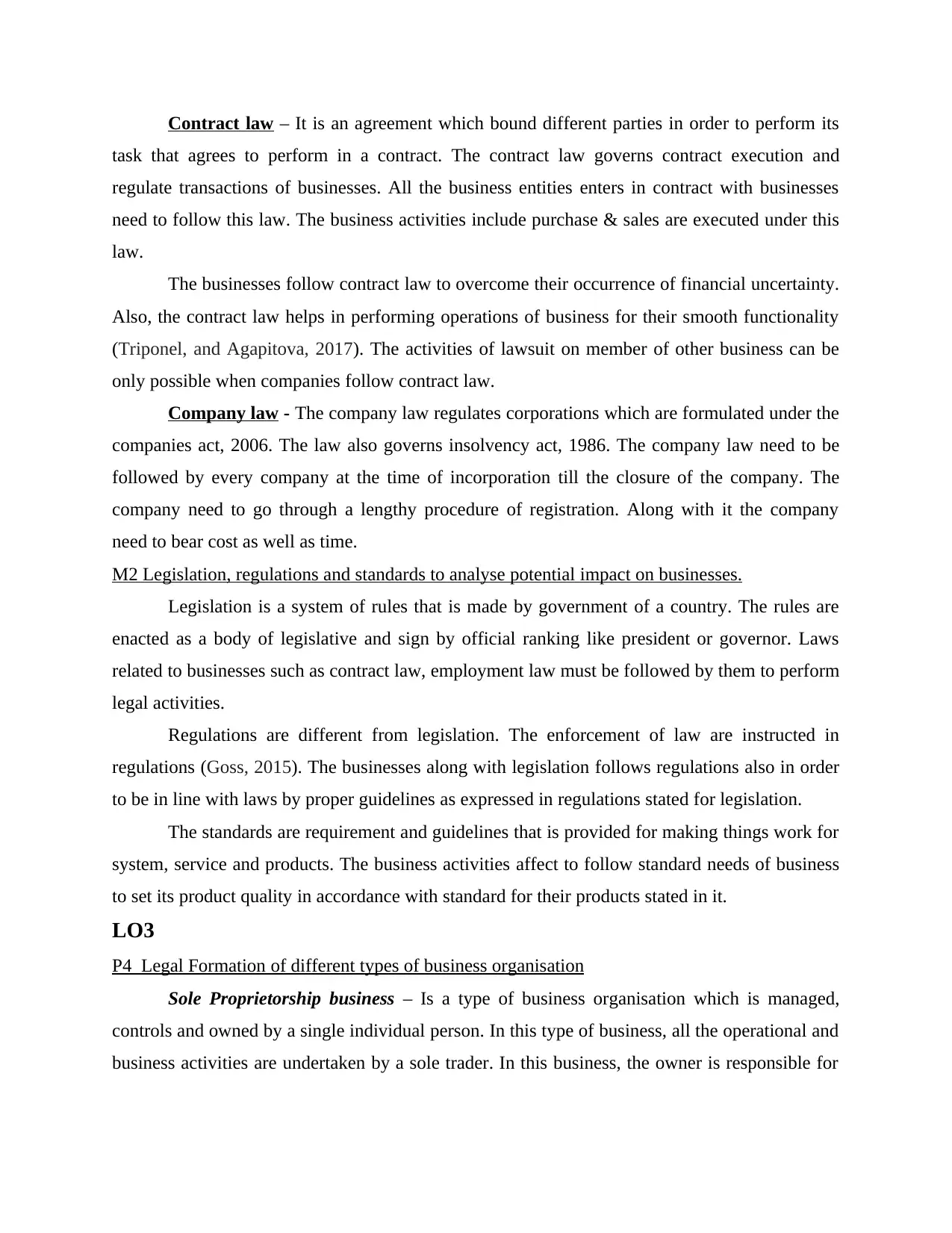
Contract law – It is an agreement which bound different parties in order to perform its
task that agrees to perform in a contract. The contract law governs contract execution and
regulate transactions of businesses. All the business entities enters in contract with businesses
need to follow this law. The business activities include purchase & sales are executed under this
law.
The businesses follow contract law to overcome their occurrence of financial uncertainty.
Also, the contract law helps in performing operations of business for their smooth functionality
(Triponel, and Agapitova, 2017). The activities of lawsuit on member of other business can be
only possible when companies follow contract law.
Company law - The company law regulates corporations which are formulated under the
companies act, 2006. The law also governs insolvency act, 1986. The company law need to be
followed by every company at the time of incorporation till the closure of the company. The
company need to go through a lengthy procedure of registration. Along with it the company
need to bear cost as well as time.
M2 Legislation, regulations and standards to analyse potential impact on businesses.
Legislation is a system of rules that is made by government of a country. The rules are
enacted as a body of legislative and sign by official ranking like president or governor. Laws
related to businesses such as contract law, employment law must be followed by them to perform
legal activities.
Regulations are different from legislation. The enforcement of law are instructed in
regulations (Goss, 2015). The businesses along with legislation follows regulations also in order
to be in line with laws by proper guidelines as expressed in regulations stated for legislation.
The standards are requirement and guidelines that is provided for making things work for
system, service and products. The business activities affect to follow standard needs of business
to set its product quality in accordance with standard for their products stated in it.
LO3
P4 Legal Formation of different types of business organisation
Sole Proprietorship business – Is a type of business organisation which is managed,
controls and owned by a single individual person. In this type of business, all the operational and
business activities are undertaken by a sole trader. In this business, the owner is responsible for
task that agrees to perform in a contract. The contract law governs contract execution and
regulate transactions of businesses. All the business entities enters in contract with businesses
need to follow this law. The business activities include purchase & sales are executed under this
law.
The businesses follow contract law to overcome their occurrence of financial uncertainty.
Also, the contract law helps in performing operations of business for their smooth functionality
(Triponel, and Agapitova, 2017). The activities of lawsuit on member of other business can be
only possible when companies follow contract law.
Company law - The company law regulates corporations which are formulated under the
companies act, 2006. The law also governs insolvency act, 1986. The company law need to be
followed by every company at the time of incorporation till the closure of the company. The
company need to go through a lengthy procedure of registration. Along with it the company
need to bear cost as well as time.
M2 Legislation, regulations and standards to analyse potential impact on businesses.
Legislation is a system of rules that is made by government of a country. The rules are
enacted as a body of legislative and sign by official ranking like president or governor. Laws
related to businesses such as contract law, employment law must be followed by them to perform
legal activities.
Regulations are different from legislation. The enforcement of law are instructed in
regulations (Goss, 2015). The businesses along with legislation follows regulations also in order
to be in line with laws by proper guidelines as expressed in regulations stated for legislation.
The standards are requirement and guidelines that is provided for making things work for
system, service and products. The business activities affect to follow standard needs of business
to set its product quality in accordance with standard for their products stated in it.
LO3
P4 Legal Formation of different types of business organisation
Sole Proprietorship business – Is a type of business organisation which is managed,
controls and owned by a single individual person. In this type of business, all the operational and
business activities are undertaken by a sole trader. In this business, the owner is responsible for
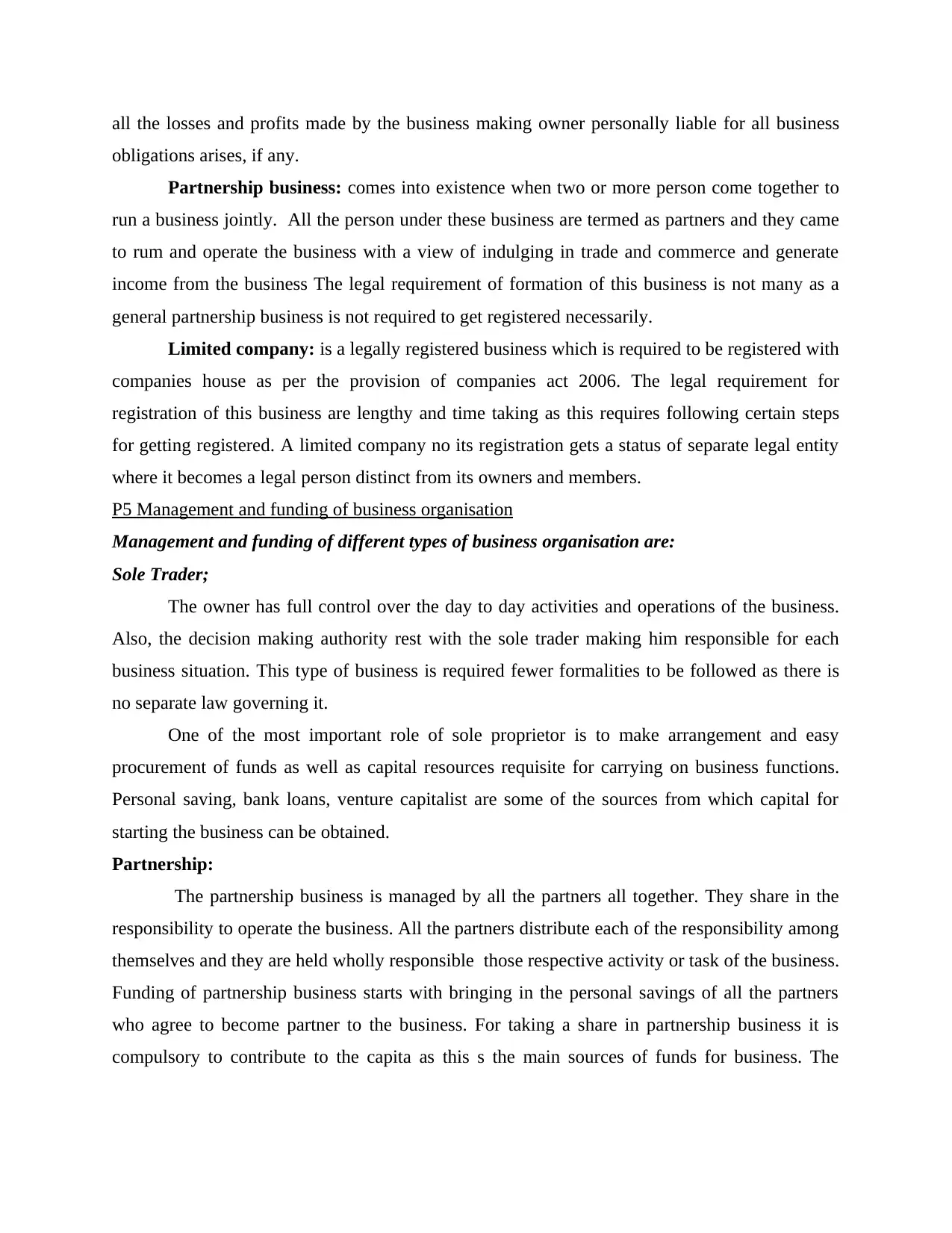
all the losses and profits made by the business making owner personally liable for all business
obligations arises, if any.
Partnership business: comes into existence when two or more person come together to
run a business jointly. All the person under these business are termed as partners and they came
to rum and operate the business with a view of indulging in trade and commerce and generate
income from the business The legal requirement of formation of this business is not many as a
general partnership business is not required to get registered necessarily.
Limited company: is a legally registered business which is required to be registered with
companies house as per the provision of companies act 2006. The legal requirement for
registration of this business are lengthy and time taking as this requires following certain steps
for getting registered. A limited company no its registration gets a status of separate legal entity
where it becomes a legal person distinct from its owners and members.
P5 Management and funding of business organisation
Management and funding of different types of business organisation are:
Sole Trader;
The owner has full control over the day to day activities and operations of the business.
Also, the decision making authority rest with the sole trader making him responsible for each
business situation. This type of business is required fewer formalities to be followed as there is
no separate law governing it.
One of the most important role of sole proprietor is to make arrangement and easy
procurement of funds as well as capital resources requisite for carrying on business functions.
Personal saving, bank loans, venture capitalist are some of the sources from which capital for
starting the business can be obtained.
Partnership:
The partnership business is managed by all the partners all together. They share in the
responsibility to operate the business. All the partners distribute each of the responsibility among
themselves and they are held wholly responsible those respective activity or task of the business.
Funding of partnership business starts with bringing in the personal savings of all the partners
who agree to become partner to the business. For taking a share in partnership business it is
compulsory to contribute to the capita as this s the main sources of funds for business. The
obligations arises, if any.
Partnership business: comes into existence when two or more person come together to
run a business jointly. All the person under these business are termed as partners and they came
to rum and operate the business with a view of indulging in trade and commerce and generate
income from the business The legal requirement of formation of this business is not many as a
general partnership business is not required to get registered necessarily.
Limited company: is a legally registered business which is required to be registered with
companies house as per the provision of companies act 2006. The legal requirement for
registration of this business are lengthy and time taking as this requires following certain steps
for getting registered. A limited company no its registration gets a status of separate legal entity
where it becomes a legal person distinct from its owners and members.
P5 Management and funding of business organisation
Management and funding of different types of business organisation are:
Sole Trader;
The owner has full control over the day to day activities and operations of the business.
Also, the decision making authority rest with the sole trader making him responsible for each
business situation. This type of business is required fewer formalities to be followed as there is
no separate law governing it.
One of the most important role of sole proprietor is to make arrangement and easy
procurement of funds as well as capital resources requisite for carrying on business functions.
Personal saving, bank loans, venture capitalist are some of the sources from which capital for
starting the business can be obtained.
Partnership:
The partnership business is managed by all the partners all together. They share in the
responsibility to operate the business. All the partners distribute each of the responsibility among
themselves and they are held wholly responsible those respective activity or task of the business.
Funding of partnership business starts with bringing in the personal savings of all the partners
who agree to become partner to the business. For taking a share in partnership business it is
compulsory to contribute to the capita as this s the main sources of funds for business. The
⊘ This is a preview!⊘
Do you want full access?
Subscribe today to unlock all pages.

Trusted by 1+ million students worldwide
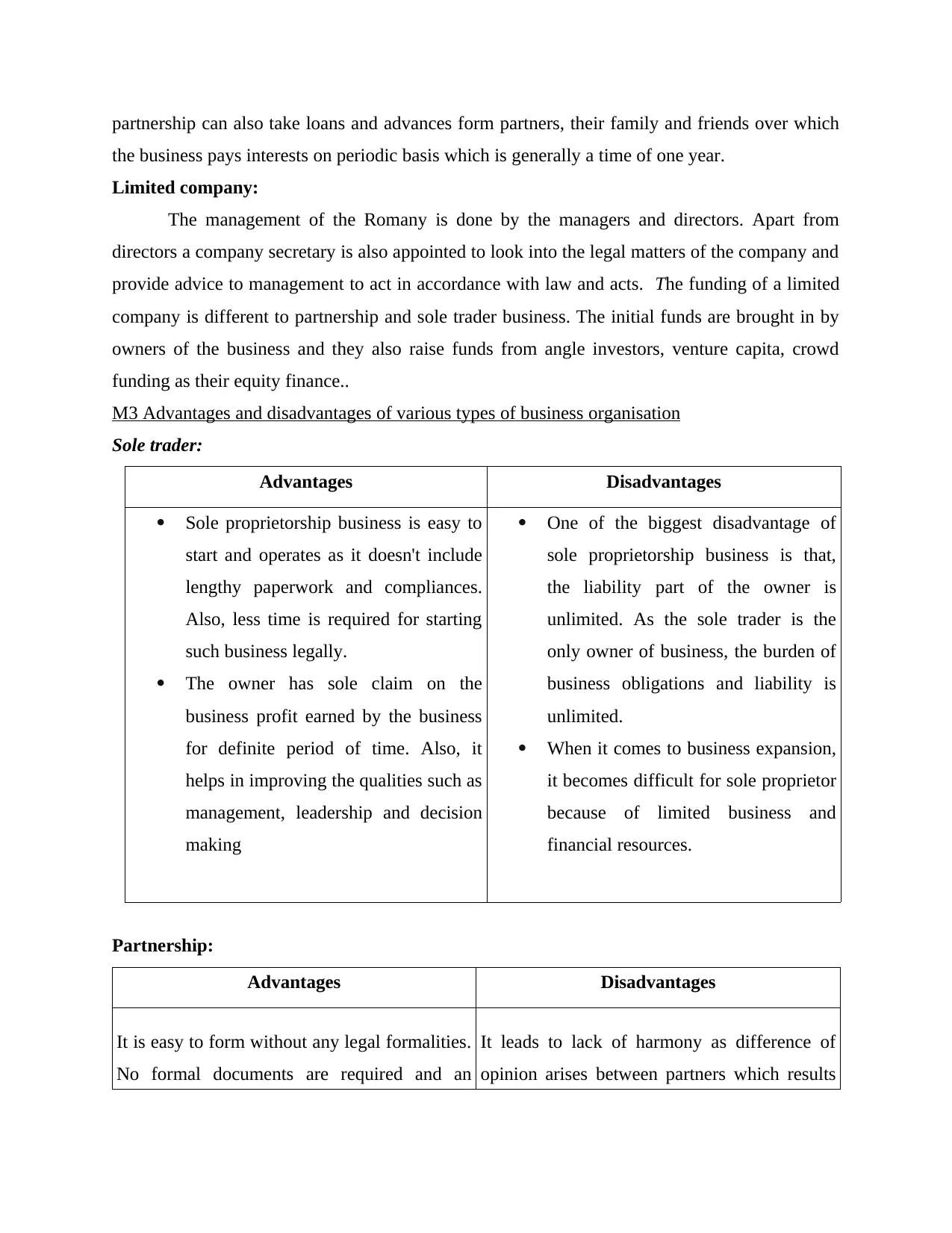
partnership can also take loans and advances form partners, their family and friends over which
the business pays interests on periodic basis which is generally a time of one year.
Limited company:
The management of the Romany is done by the managers and directors. Apart from
directors a company secretary is also appointed to look into the legal matters of the company and
provide advice to management to act in accordance with law and acts. The funding of a limited
company is different to partnership and sole trader business. The initial funds are brought in by
owners of the business and they also raise funds from angle investors, venture capita, crowd
funding as their equity finance..
M3 Advantages and disadvantages of various types of business organisation
Sole trader:
Advantages Disadvantages
Sole proprietorship business is easy to
start and operates as it doesn't include
lengthy paperwork and compliances.
Also, less time is required for starting
such business legally.
The owner has sole claim on the
business profit earned by the business
for definite period of time. Also, it
helps in improving the qualities such as
management, leadership and decision
making
One of the biggest disadvantage of
sole proprietorship business is that,
the liability part of the owner is
unlimited. As the sole trader is the
only owner of business, the burden of
business obligations and liability is
unlimited.
When it comes to business expansion,
it becomes difficult for sole proprietor
because of limited business and
financial resources.
Partnership:
Advantages Disadvantages
It is easy to form without any legal formalities.
No formal documents are required and an
It leads to lack of harmony as difference of
opinion arises between partners which results
the business pays interests on periodic basis which is generally a time of one year.
Limited company:
The management of the Romany is done by the managers and directors. Apart from
directors a company secretary is also appointed to look into the legal matters of the company and
provide advice to management to act in accordance with law and acts. The funding of a limited
company is different to partnership and sole trader business. The initial funds are brought in by
owners of the business and they also raise funds from angle investors, venture capita, crowd
funding as their equity finance..
M3 Advantages and disadvantages of various types of business organisation
Sole trader:
Advantages Disadvantages
Sole proprietorship business is easy to
start and operates as it doesn't include
lengthy paperwork and compliances.
Also, less time is required for starting
such business legally.
The owner has sole claim on the
business profit earned by the business
for definite period of time. Also, it
helps in improving the qualities such as
management, leadership and decision
making
One of the biggest disadvantage of
sole proprietorship business is that,
the liability part of the owner is
unlimited. As the sole trader is the
only owner of business, the burden of
business obligations and liability is
unlimited.
When it comes to business expansion,
it becomes difficult for sole proprietor
because of limited business and
financial resources.
Partnership:
Advantages Disadvantages
It is easy to form without any legal formalities.
No formal documents are required and an
It leads to lack of harmony as difference of
opinion arises between partners which results
Paraphrase This Document
Need a fresh take? Get an instant paraphrase of this document with our AI Paraphraser
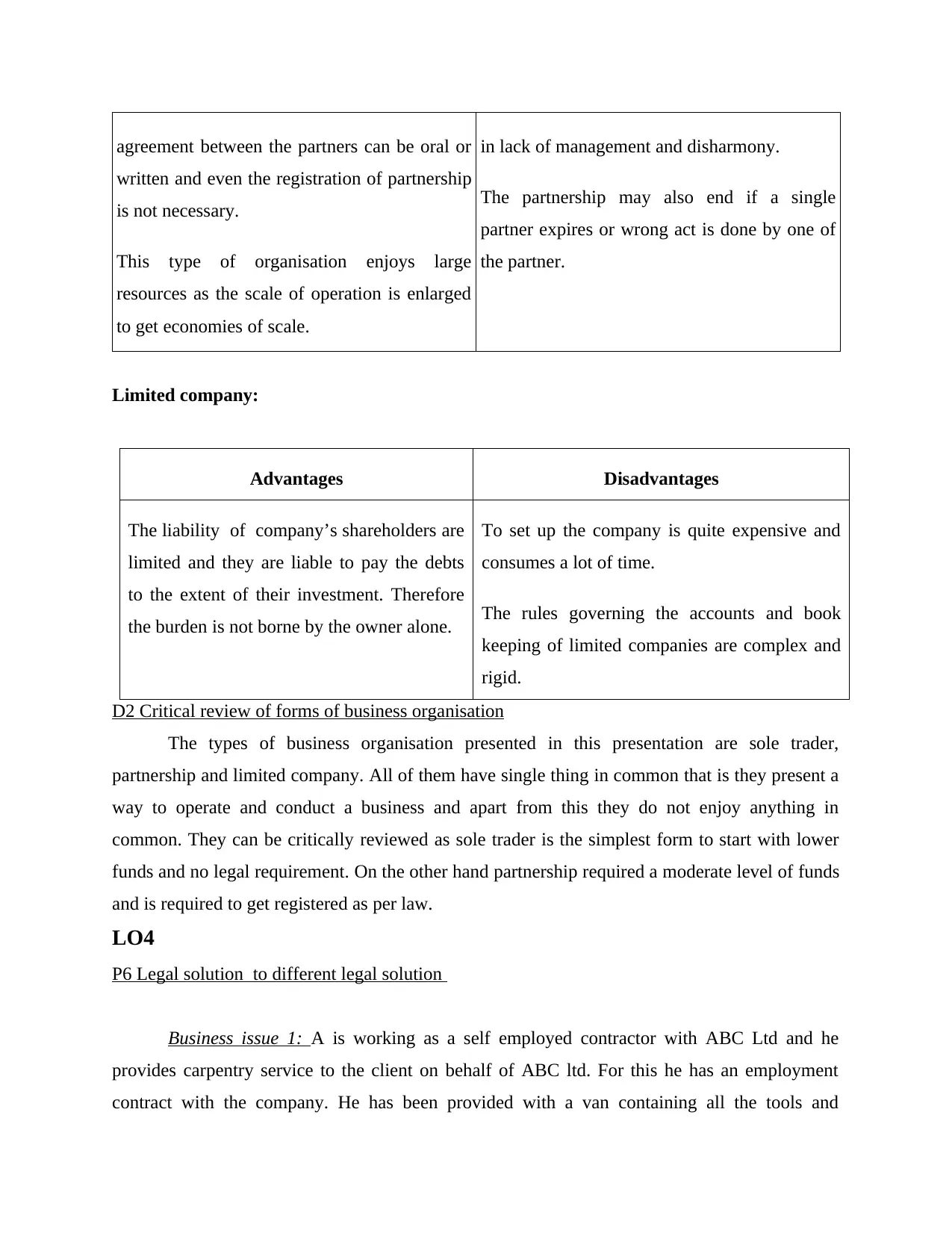
agreement between the partners can be oral or
written and even the registration of partnership
is not necessary.
This type of organisation enjoys large
resources as the scale of operation is enlarged
to get economies of scale.
in lack of management and disharmony.
The partnership may also end if a single
partner expires or wrong act is done by one of
the partner.
Limited company:
Advantages Disadvantages
The liability of company’s shareholders are
limited and they are liable to pay the debts
to the extent of their investment. Therefore
the burden is not borne by the owner alone.
To set up the company is quite expensive and
consumes a lot of time.
The rules governing the accounts and book
keeping of limited companies are complex and
rigid.
D2 Critical review of forms of business organisation
The types of business organisation presented in this presentation are sole trader,
partnership and limited company. All of them have single thing in common that is they present a
way to operate and conduct a business and apart from this they do not enjoy anything in
common. They can be critically reviewed as sole trader is the simplest form to start with lower
funds and no legal requirement. On the other hand partnership required a moderate level of funds
and is required to get registered as per law.
LO4
P6 Legal solution to different legal solution
Business issue 1: A is working as a self employed contractor with ABC Ltd and he
provides carpentry service to the client on behalf of ABC ltd. For this he has an employment
contract with the company. He has been provided with a van containing all the tools and
written and even the registration of partnership
is not necessary.
This type of organisation enjoys large
resources as the scale of operation is enlarged
to get economies of scale.
in lack of management and disharmony.
The partnership may also end if a single
partner expires or wrong act is done by one of
the partner.
Limited company:
Advantages Disadvantages
The liability of company’s shareholders are
limited and they are liable to pay the debts
to the extent of their investment. Therefore
the burden is not borne by the owner alone.
To set up the company is quite expensive and
consumes a lot of time.
The rules governing the accounts and book
keeping of limited companies are complex and
rigid.
D2 Critical review of forms of business organisation
The types of business organisation presented in this presentation are sole trader,
partnership and limited company. All of them have single thing in common that is they present a
way to operate and conduct a business and apart from this they do not enjoy anything in
common. They can be critically reviewed as sole trader is the simplest form to start with lower
funds and no legal requirement. On the other hand partnership required a moderate level of funds
and is required to get registered as per law.
LO4
P6 Legal solution to different legal solution
Business issue 1: A is working as a self employed contractor with ABC Ltd and he
provides carpentry service to the client on behalf of ABC ltd. For this he has an employment
contract with the company. He has been provided with a van containing all the tools and
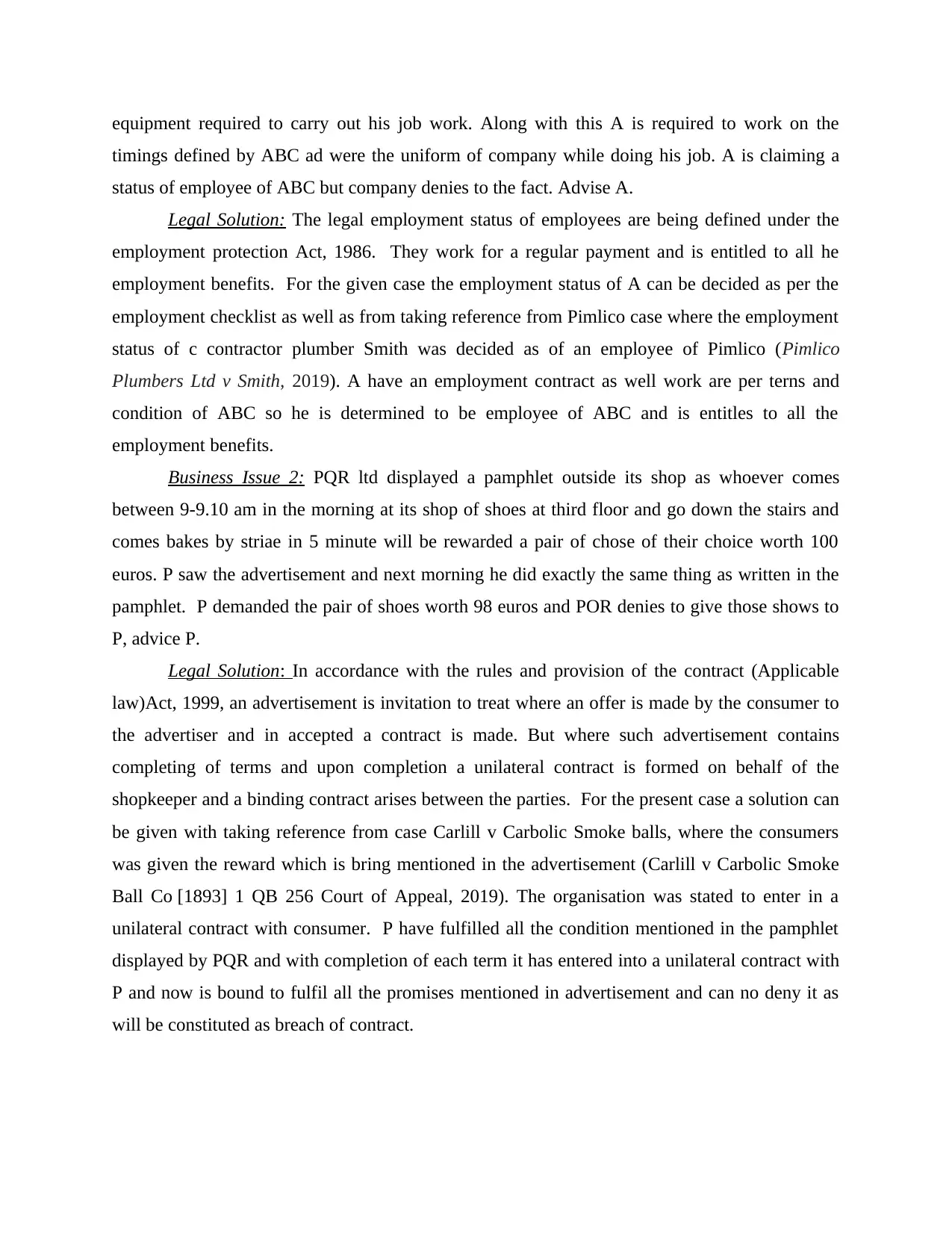
equipment required to carry out his job work. Along with this A is required to work on the
timings defined by ABC ad were the uniform of company while doing his job. A is claiming a
status of employee of ABC but company denies to the fact. Advise A.
Legal Solution: The legal employment status of employees are being defined under the
employment protection Act, 1986. They work for a regular payment and is entitled to all he
employment benefits. For the given case the employment status of A can be decided as per the
employment checklist as well as from taking reference from Pimlico case where the employment
status of c contractor plumber Smith was decided as of an employee of Pimlico (Pimlico
Plumbers Ltd v Smith, 2019). A have an employment contract as well work are per terns and
condition of ABC so he is determined to be employee of ABC and is entitles to all the
employment benefits.
Business Issue 2: PQR ltd displayed a pamphlet outside its shop as whoever comes
between 9-9.10 am in the morning at its shop of shoes at third floor and go down the stairs and
comes bakes by striae in 5 minute will be rewarded a pair of chose of their choice worth 100
euros. P saw the advertisement and next morning he did exactly the same thing as written in the
pamphlet. P demanded the pair of shoes worth 98 euros and POR denies to give those shows to
P, advice P.
Legal Solution: In accordance with the rules and provision of the contract (Applicable
law)Act, 1999, an advertisement is invitation to treat where an offer is made by the consumer to
the advertiser and in accepted a contract is made. But where such advertisement contains
completing of terms and upon completion a unilateral contract is formed on behalf of the
shopkeeper and a binding contract arises between the parties. For the present case a solution can
be given with taking reference from case Carlill v Carbolic Smoke balls, where the consumers
was given the reward which is bring mentioned in the advertisement (Carlill v Carbolic Smoke
Ball Co [1893] 1 QB 256 Court of Appeal, 2019). The organisation was stated to enter in a
unilateral contract with consumer. P have fulfilled all the condition mentioned in the pamphlet
displayed by PQR and with completion of each term it has entered into a unilateral contract with
P and now is bound to fulfil all the promises mentioned in advertisement and can no deny it as
will be constituted as breach of contract.
timings defined by ABC ad were the uniform of company while doing his job. A is claiming a
status of employee of ABC but company denies to the fact. Advise A.
Legal Solution: The legal employment status of employees are being defined under the
employment protection Act, 1986. They work for a regular payment and is entitled to all he
employment benefits. For the given case the employment status of A can be decided as per the
employment checklist as well as from taking reference from Pimlico case where the employment
status of c contractor plumber Smith was decided as of an employee of Pimlico (Pimlico
Plumbers Ltd v Smith, 2019). A have an employment contract as well work are per terns and
condition of ABC so he is determined to be employee of ABC and is entitles to all the
employment benefits.
Business Issue 2: PQR ltd displayed a pamphlet outside its shop as whoever comes
between 9-9.10 am in the morning at its shop of shoes at third floor and go down the stairs and
comes bakes by striae in 5 minute will be rewarded a pair of chose of their choice worth 100
euros. P saw the advertisement and next morning he did exactly the same thing as written in the
pamphlet. P demanded the pair of shoes worth 98 euros and POR denies to give those shows to
P, advice P.
Legal Solution: In accordance with the rules and provision of the contract (Applicable
law)Act, 1999, an advertisement is invitation to treat where an offer is made by the consumer to
the advertiser and in accepted a contract is made. But where such advertisement contains
completing of terms and upon completion a unilateral contract is formed on behalf of the
shopkeeper and a binding contract arises between the parties. For the present case a solution can
be given with taking reference from case Carlill v Carbolic Smoke balls, where the consumers
was given the reward which is bring mentioned in the advertisement (Carlill v Carbolic Smoke
Ball Co [1893] 1 QB 256 Court of Appeal, 2019). The organisation was stated to enter in a
unilateral contract with consumer. P have fulfilled all the condition mentioned in the pamphlet
displayed by PQR and with completion of each term it has entered into a unilateral contract with
P and now is bound to fulfil all the promises mentioned in advertisement and can no deny it as
will be constituted as breach of contract.
⊘ This is a preview!⊘
Do you want full access?
Subscribe today to unlock all pages.

Trusted by 1+ million students worldwide
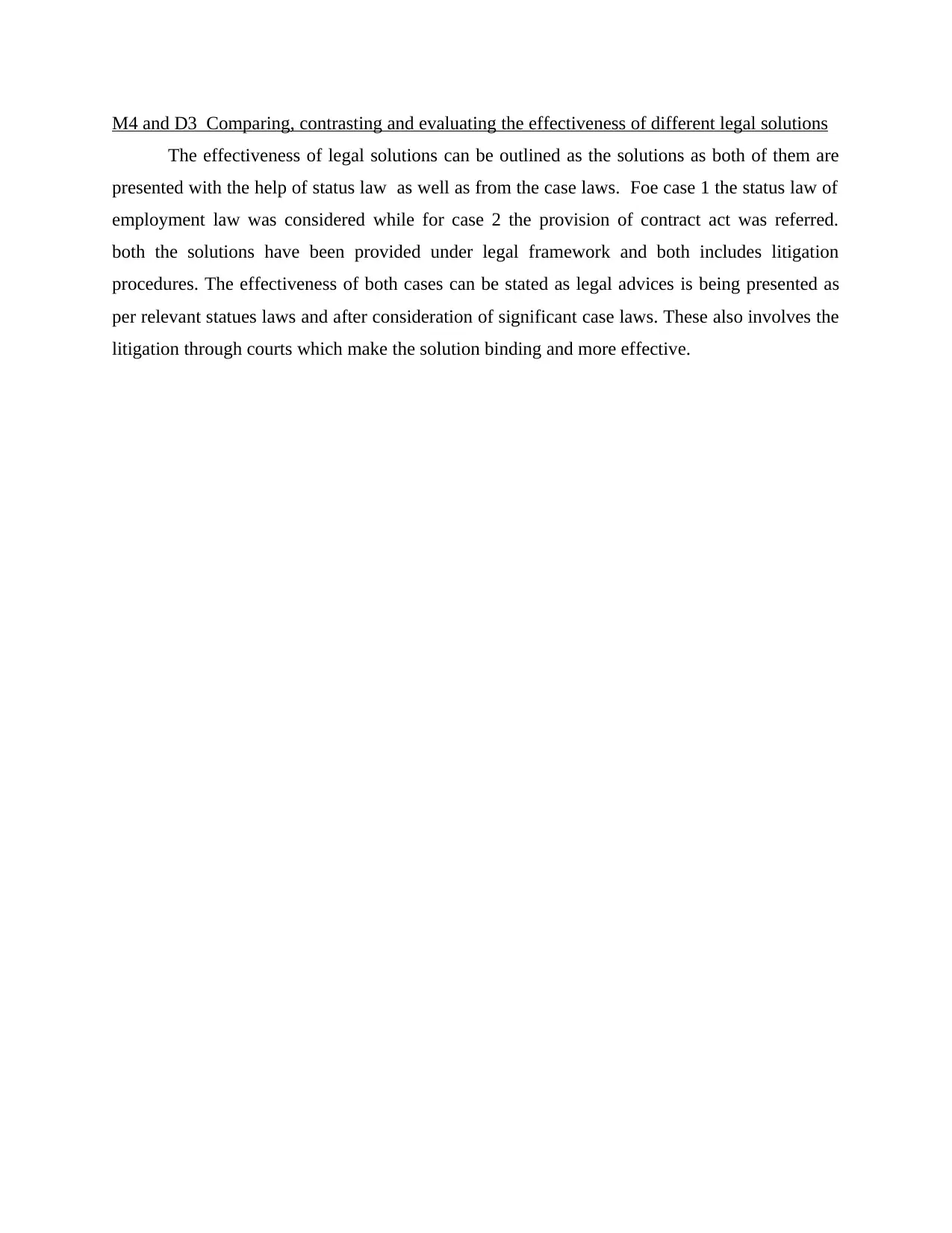
M4 and D3 Comparing, contrasting and evaluating the effectiveness of different legal solutions
The effectiveness of legal solutions can be outlined as the solutions as both of them are
presented with the help of status law as well as from the case laws. Foe case 1 the status law of
employment law was considered while for case 2 the provision of contract act was referred.
both the solutions have been provided under legal framework and both includes litigation
procedures. The effectiveness of both cases can be stated as legal advices is being presented as
per relevant statues laws and after consideration of significant case laws. These also involves the
litigation through courts which make the solution binding and more effective.
The effectiveness of legal solutions can be outlined as the solutions as both of them are
presented with the help of status law as well as from the case laws. Foe case 1 the status law of
employment law was considered while for case 2 the provision of contract act was referred.
both the solutions have been provided under legal framework and both includes litigation
procedures. The effectiveness of both cases can be stated as legal advices is being presented as
per relevant statues laws and after consideration of significant case laws. These also involves the
litigation through courts which make the solution binding and more effective.
Paraphrase This Document
Need a fresh take? Get an instant paraphrase of this document with our AI Paraphraser
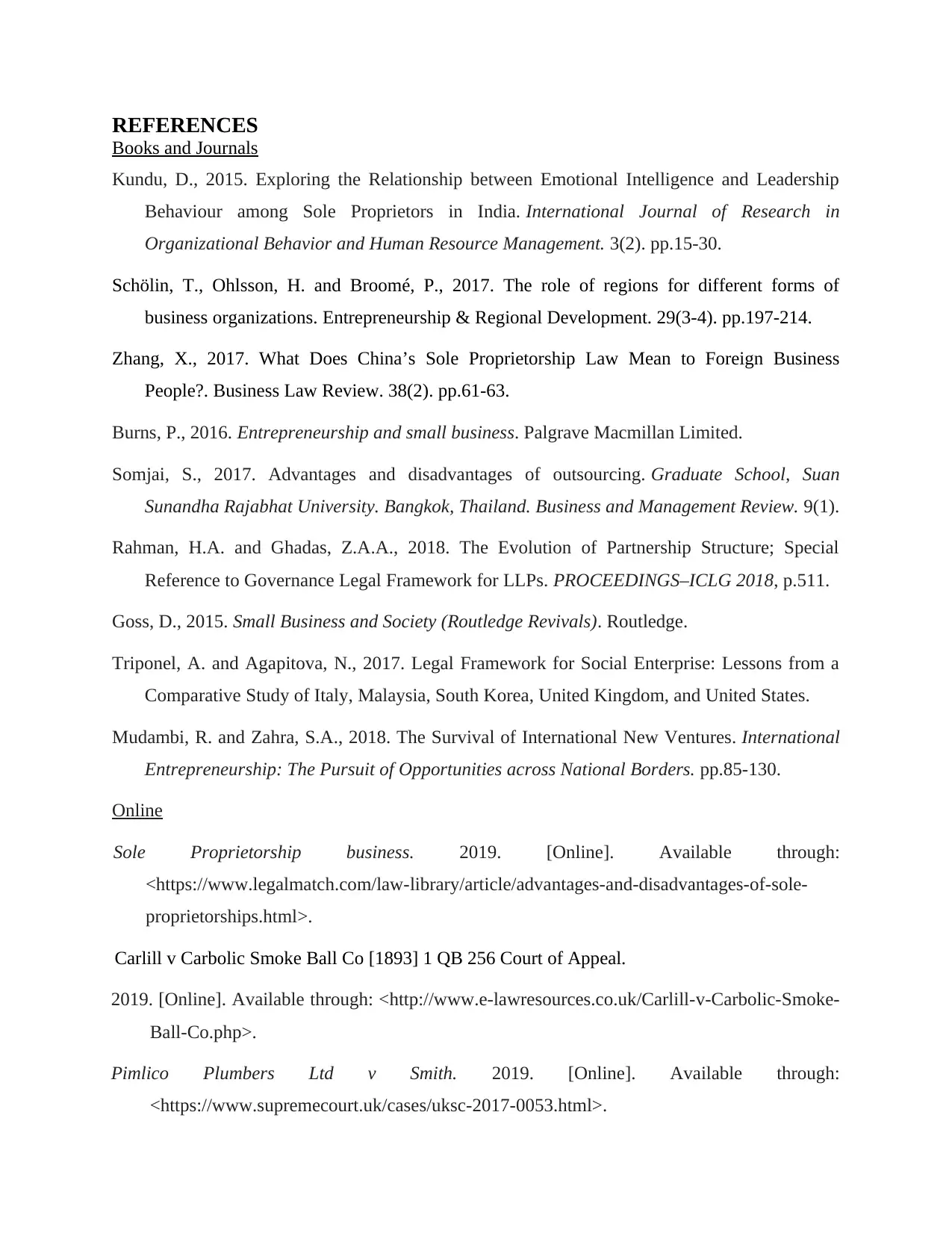
REFERENCES
Books and Journals
Kundu, D., 2015. Exploring the Relationship between Emotional Intelligence and Leadership
Behaviour among Sole Proprietors in India. International Journal of Research in
Organizational Behavior and Human Resource Management. 3(2). pp.15-30.
Schölin, T., Ohlsson, H. and Broomé, P., 2017. The role of regions for different forms of
business organizations. Entrepreneurship & Regional Development. 29(3-4). pp.197-214.
Zhang, X., 2017. What Does China’s Sole Proprietorship Law Mean to Foreign Business
People?. Business Law Review. 38(2). pp.61-63.
Burns, P., 2016. Entrepreneurship and small business. Palgrave Macmillan Limited.
Somjai, S., 2017. Advantages and disadvantages of outsourcing. Graduate School, Suan
Sunandha Rajabhat University. Bangkok, Thailand. Business and Management Review. 9(1).
Rahman, H.A. and Ghadas, Z.A.A., 2018. The Evolution of Partnership Structure; Special
Reference to Governance Legal Framework for LLPs. PROCEEDINGS–ICLG 2018, p.511.
Goss, D., 2015. Small Business and Society (Routledge Revivals). Routledge.
Triponel, A. and Agapitova, N., 2017. Legal Framework for Social Enterprise: Lessons from a
Comparative Study of Italy, Malaysia, South Korea, United Kingdom, and United States.
Mudambi, R. and Zahra, S.A., 2018. The Survival of International New Ventures. International
Entrepreneurship: The Pursuit of Opportunities across National Borders. pp.85-130.
Online
Sole Proprietorship business. 2019. [Online]. Available through:
<https://www.legalmatch.com/law-library/article/advantages-and-disadvantages-of-sole-
proprietorships.html>.
Carlill v Carbolic Smoke Ball Co [1893] 1 QB 256 Court of Appeal.
2019. [Online]. Available through: <http://www.e-lawresources.co.uk/Carlill-v-Carbolic-Smoke-
Ball-Co.php>.
Pimlico Plumbers Ltd v Smith. 2019. [Online]. Available through:
<https://www.supremecourt.uk/cases/uksc-2017-0053.html>.
Books and Journals
Kundu, D., 2015. Exploring the Relationship between Emotional Intelligence and Leadership
Behaviour among Sole Proprietors in India. International Journal of Research in
Organizational Behavior and Human Resource Management. 3(2). pp.15-30.
Schölin, T., Ohlsson, H. and Broomé, P., 2017. The role of regions for different forms of
business organizations. Entrepreneurship & Regional Development. 29(3-4). pp.197-214.
Zhang, X., 2017. What Does China’s Sole Proprietorship Law Mean to Foreign Business
People?. Business Law Review. 38(2). pp.61-63.
Burns, P., 2016. Entrepreneurship and small business. Palgrave Macmillan Limited.
Somjai, S., 2017. Advantages and disadvantages of outsourcing. Graduate School, Suan
Sunandha Rajabhat University. Bangkok, Thailand. Business and Management Review. 9(1).
Rahman, H.A. and Ghadas, Z.A.A., 2018. The Evolution of Partnership Structure; Special
Reference to Governance Legal Framework for LLPs. PROCEEDINGS–ICLG 2018, p.511.
Goss, D., 2015. Small Business and Society (Routledge Revivals). Routledge.
Triponel, A. and Agapitova, N., 2017. Legal Framework for Social Enterprise: Lessons from a
Comparative Study of Italy, Malaysia, South Korea, United Kingdom, and United States.
Mudambi, R. and Zahra, S.A., 2018. The Survival of International New Ventures. International
Entrepreneurship: The Pursuit of Opportunities across National Borders. pp.85-130.
Online
Sole Proprietorship business. 2019. [Online]. Available through:
<https://www.legalmatch.com/law-library/article/advantages-and-disadvantages-of-sole-
proprietorships.html>.
Carlill v Carbolic Smoke Ball Co [1893] 1 QB 256 Court of Appeal.
2019. [Online]. Available through: <http://www.e-lawresources.co.uk/Carlill-v-Carbolic-Smoke-
Ball-Co.php>.
Pimlico Plumbers Ltd v Smith. 2019. [Online]. Available through:
<https://www.supremecourt.uk/cases/uksc-2017-0053.html>.

⊘ This is a preview!⊘
Do you want full access?
Subscribe today to unlock all pages.

Trusted by 1+ million students worldwide
1 out of 12
Related Documents
Your All-in-One AI-Powered Toolkit for Academic Success.
+13062052269
info@desklib.com
Available 24*7 on WhatsApp / Email
![[object Object]](/_next/static/media/star-bottom.7253800d.svg)
Unlock your academic potential
Copyright © 2020–2025 A2Z Services. All Rights Reserved. Developed and managed by ZUCOL.




